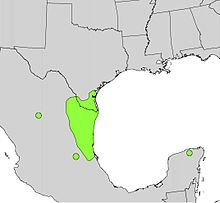Ebenopsis ebano
| Ebenopsis ebano | |
|---|---|

| |
| Fruit | |
| Scientific classification | |
| Kingdom: | Plantae |
| Clade: | Tracheophytes |
| Clade: | Angiosperms |
| Clade: | Eudicots |
| Clade: | Rosids |
| Order: | Fabales |
| Family: | Fabaceae |
| Subfamily: | Caesalpinioideae |
| Clade: | Mimosoid clade |
| Genus: | Ebenopsis |
| Species: | E. ebano
|
| Binomial name | |
| Ebenopsis ebano | |

| |
| Natural range | |
| Synonyms | |
|
Acacia flexicaulis Benth. | |
Ebenopsis ebano is a species of flowering plant in the family Fabaceae,[2] that is native to the coastal plain of southern Texas in the United States and eastern Mexico.[3] It is commonly known as Texas ebony or ebano (in Spanish).[2]
Description
Texas ebony is a small, evergreen tree that reaches a height of 7.6–9.1 m (25–30 ft) and a crown width of 1.8–4.6 m (5.9–15.1 ft).[4]

Habitat and range
The range of E. ebano stretches from
Uses
Texas ebony is cultivated in xeriscaping for its dense foliage and fragrant flowers.[10] It is also used in bonsai.[11]
Ecology
Ebenopsis ebano is a
References
- ^ Contu, S. (2012). "Ebenopsis ebano". IUCN Red List of Threatened Species. 2012: e.T19891615A20070381. Retrieved 14 March 2023.
- ^ a b c "Ebenopsis ebano". Germplasm Resources Information Network. Agricultural Research Service, United States Department of Agriculture. Retrieved 2009-11-25.
- ^ "Ebenopsis ebano (Texas Ebony)". Native Plant Database. Lady Bird Johnson Wildflower Center. Retrieved 2009-07-06.
- ISBN 978-0-88192-905-8.
- ^ "Ebenopsis ebano (Berl.) Barneby & Grimes Texas ebony". The PLANTS Database. United States Department of Agriculture. Retrieved 2010-11-25.
- ^ CONAFOR. Retrieved 2009-07-09.
- .
- ISBN 978-0-231-11157-7.
- ISBN 978-1-56656-640-7.
- ISBN 978-0-7603-2968-9.
- ISBN 978-1-889538-42-6.
- ^ "Coyote Cloudywing Achalarus toxeus (Plötz, 1882)". Butterflies and Moths of North America. Retrieved 2010-03-30.
- ^ "Sphingicampa blanchardi". Butterflies and Moths of North America. Retrieved November 16, 2018.
- ^ Fox, Charles W. (2006). "Colonization of a new host by a seed-feeding beetle: Genetic variation, maternal experience, and the effect of an alternate host" (PDF). Annales Zoologici Fennici. 43: 239–247.
- ^ Sill, Sue (May 2009). "Tillandsia baileyi rose - Texas's Disappearing Native Air-Plant" (PDF). The Sabal. 26 (5). Native Plant Project: 1–5.
External links
- "Texas Ebony, Ebano, Ebony Blackbeard, Ebony Apes-earring Pithecellobium flexicaule". Benny Simpson's Native Trees of Texas. Texas A&M University.
- "Pithecellobium flexicaule" (PDF). Digital Representations of Tree Species Range Maps from "Atlas of United States Trees" by Elbert L. Little, Jr. (and other publications). United States Geological Survey.
 Media related to Ebenopsis ebano at Wikimedia Commons
Media related to Ebenopsis ebano at Wikimedia Commons Data related to Ebenopsis ebano at Wikispecies
Data related to Ebenopsis ebano at Wikispecies

